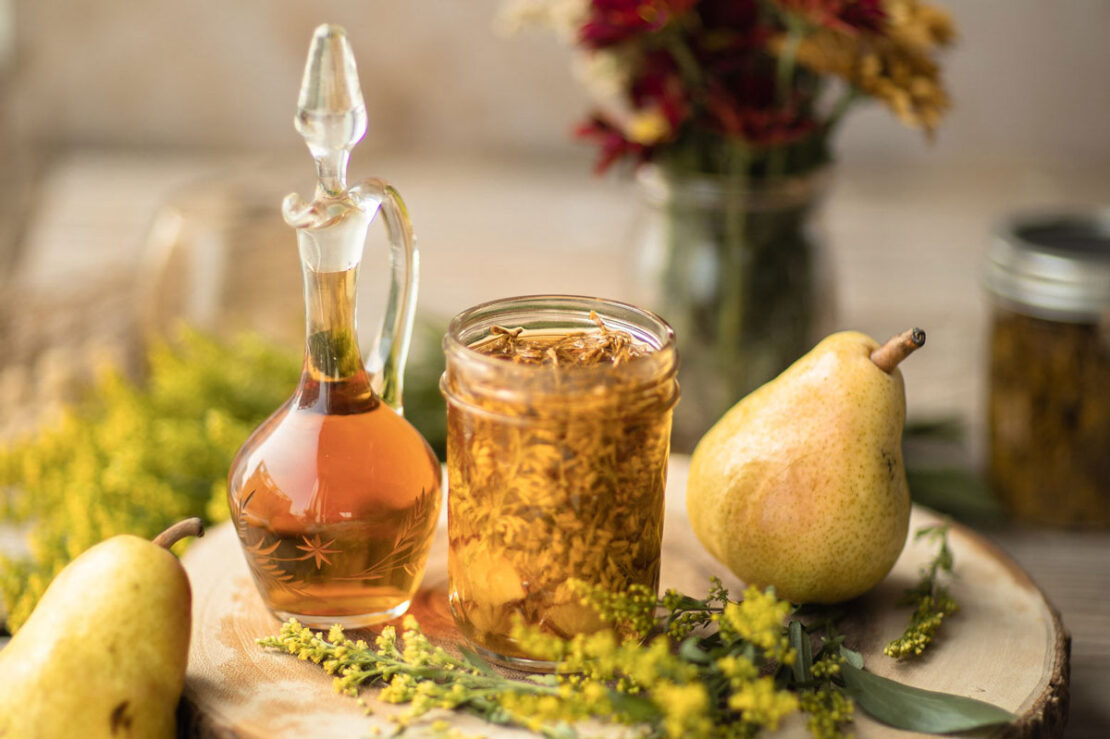
Using Goldenrod: A Late Summer Cordial Recipe
Goldenrod (Solidago spp.) flourishes abundantly on roadsides and meadows in late summer and fall. In the plant family, Asteraceae, the genus name “Solidago” is derived from the Latin word “solidare” which translates to, “make whole or heal.” This is a helpful clue into the many ways people have been using goldenrod for centuries.
Aptly named, goldenrod flowers have a gorgeous golden hue and the plant can stand up to four-feet-tall (Vorderbruggen, 2015). Goldenrod can be infused in oil and used in salves for inflammation or used in tea or tincture to aid in respiratory congestion and seasonal allergies. You can also make a luscious anise-flavored goldenrod cordial for fall sipping (keep reading for the recipe!).
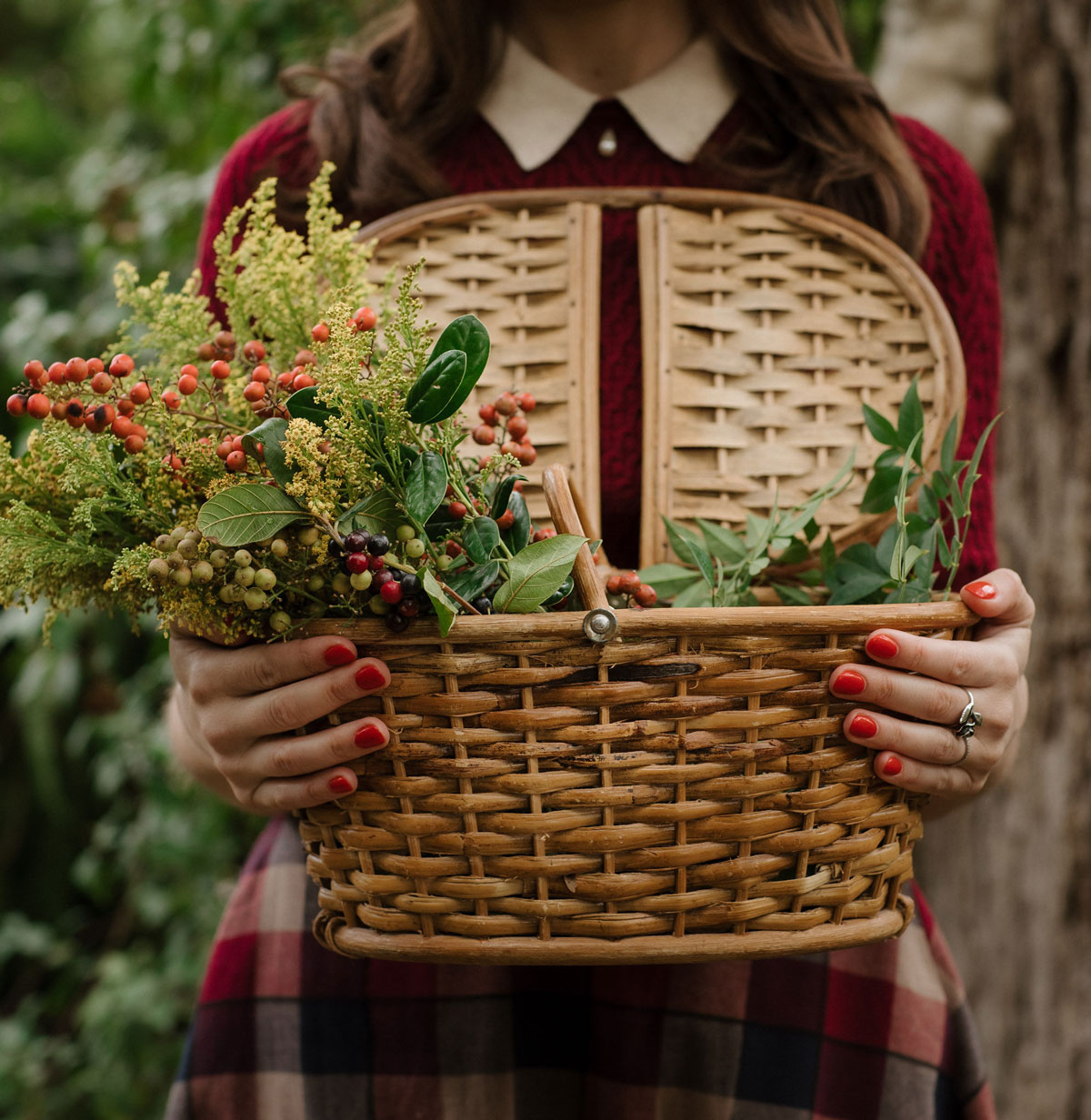
The Benefits of Goldenrod
Goldenrod is a bitter aromatic herb with an anise flavor. It’s great for cleansing the kidneys, liver, and urinary tract, acting somewhat like a broom by sweeping out the system. It contains flavonoids, saponins, and tannins, making it an antimicrobial and antiseptic ally. Topically, goldenrod can be used as a salve to increase blood flow to a particular area of the body (Herbal Academy, n.d.).
How to Harvest Goldenrod
Goldenrod is sometimes mistaken for ragweed (Ambrosia psilostachya)—the culprit of allergies. However, there are some ways to tell them apart. Primarily, goldenrod flowers are a much more striking golden color compared to ragweed’s small, green-tinted buds, and goldenrod’s flowers are arranged in a more robust plume. (Learn more in Goldenrod vs. Ragweed: They’re Not the Same Plant!)
Goldenrod grows in disturbed areas across most of the United States often lining roadsides and highways, flowering between July and August. It’s abundant near my great grandpa’s farm, and when the golden flowers become clearly visible, I know fall has officially arrived in Texas. It’s best to harvest the flowers and leaves in the morning when the flowers have just opened. When harvesting, cut above the spot where the leaf joins the stem. This will encourage the plant to send up three or four new shoots from the cut.
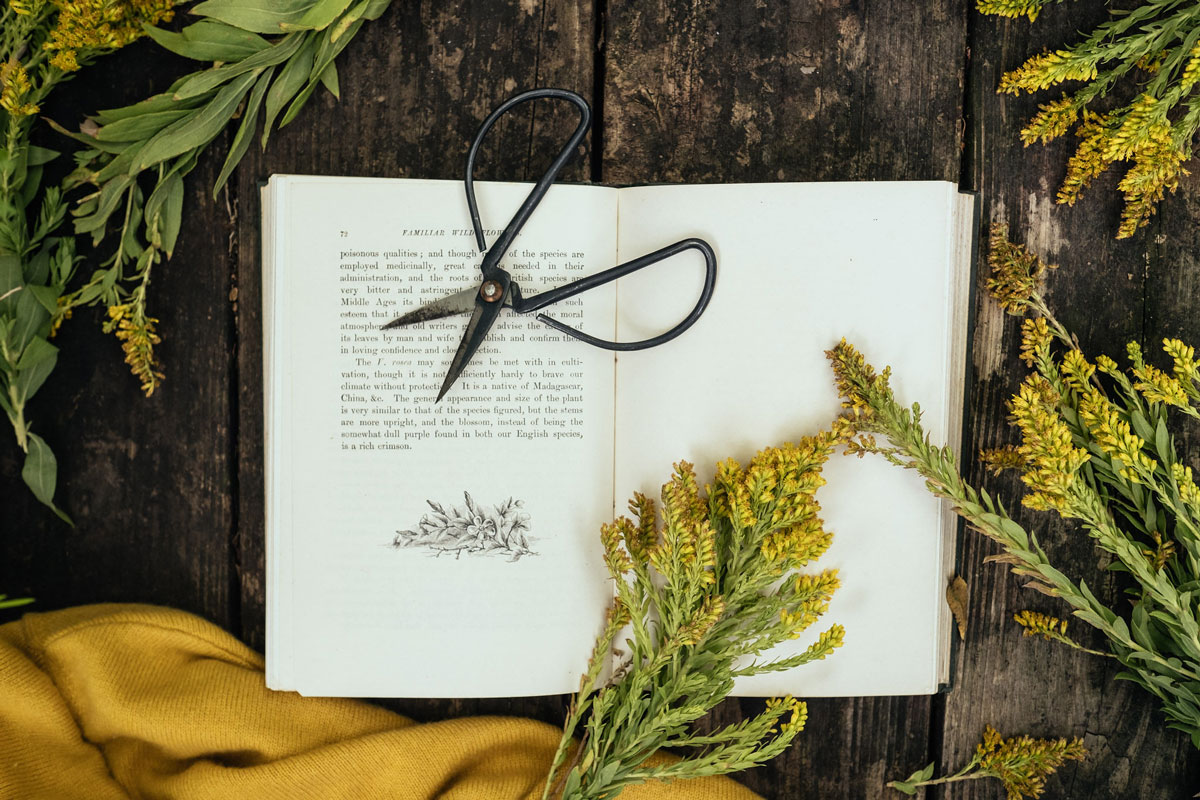
Using Goldenrod
There are many fun and creative ways that you can explore using goldenrod in your home and apothecary. A few of my favorites are:
- A striking centerpiece for your fall-themed table
- Natural dye for silk scarves, table linens, or wool yarn
- Goldenrod-infused oil and/or salve
- Tincture
- Tea or infusion
- Infused honey
- Garnish in soups, stews, or even omelets!
- A late-summer cordial
So What Is a Cordial?
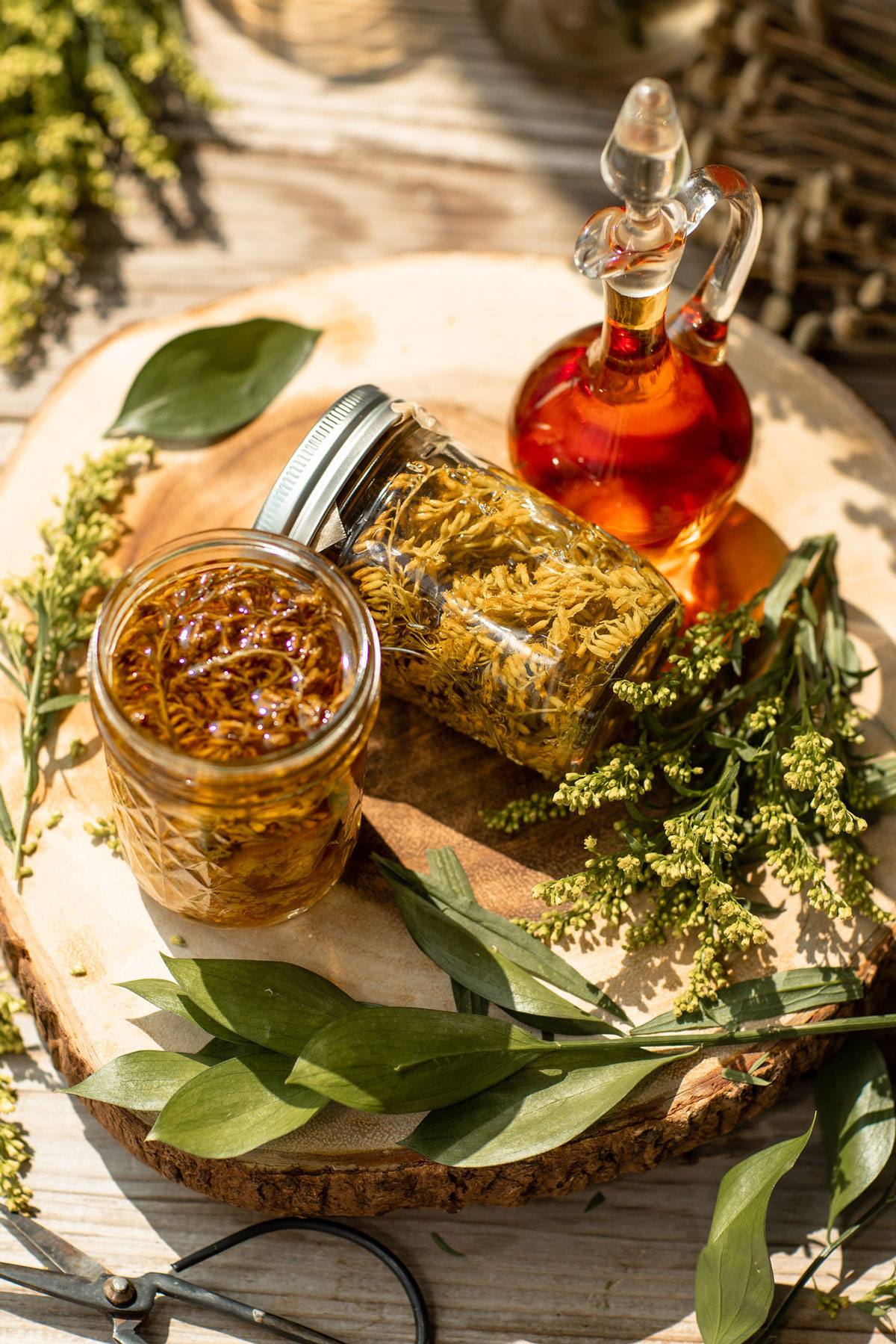
Cordials and elixirs are botanically infused alcoholic beverages or ingredients made for sipping. Cordial is derived from Latin cordiālis, meaning, “of the heart” and can give a warming, gladdening feeling. The line between elixirs and cordials has become blurred over the years, but most often, cordials contain fruit and a more pleasant-tasting alcohol, such as brandy, bourbon, tequila, or vodka. After macerating herbs and alcohol together, adding sweetener will lend the cordial a more palatable flavor for sipping. Cordials can last up to five years if stored properly, and they make great holiday gifts for friends and family.
Goldenrod and Pear Cordial
Like most herbal preparations, there are a few methods for making cordials. The first method is quick and can be ready to sip on in a few hours, while the second takes a month to fully macerate, infusing the flavors of the alcohol and herbs together. I recommend the longer, more traditional method, but the quick one can work in a fix.
1 cup fresh, chopped goldenrod (Solidago spp.) flower (or ½ cup dried)
2 ounces chopped pear
1 cinnamon (Cinnamomum zeylanicum) stick
Brandy to cover (about 6-8 ounces). You can also use another agreeable alcohol like bourbon, vodka, or tequila.
Honey, to taste. You can also use simple syrup, molasses, or fruit concentrate.
Materials
One 8-ounce glass canning jar with lid
Label
Kitchen scale
Cheesecloth
For the quick cordial: Combine goldenrod, pears, and cinnamon in a large bowl with 32 ounces of distilled water. Cover and soak for 3-4 hours. Transfer to a saucepan and let simmer until the volume is reduced by nearly one-third, about (12 ounces).
Remove from heat and strain through cheesecloth. Add honey once it is cooled, then add 8 ounces of brandy. Stir well to combine. Transfer to clean, dried bottles with sterilized caps. Label the bottle and store in the refrigerator for approximately two weeks. Makes about 20 ounces.
For the longer method: Pack goldenrod, pears, and cinnamon in a clean, 8-ounce canning jar up to ¾ of the way full. Pour alcohol over the plant material and cover by at least two inches. Make sure all plant material is completely submerged. Cover with a piece of parchment paper sandwiched between the lid and the jar, then store somewhere cool and dark for 3 to 4 weeks (longer if you want it to be stronger).
Remember to shake your jar every few days to keep the plant material submerged. After 4 weeks, strain through a cheesecloth, squeezing out the excess liquid. Add about ¼ to ½ parts sweetener to the liquid (or add sweetener to taste.) Bottle in clean, dry glass jars, label, and store for up to five years. Makes approximately 7 ounces.
To use, sip on a few ounces of this delightful goldenrod and pear cordial any time you need a special treat. It’s particularly wonderful when served as an after-dinner aperitif! FYI, because there’s no water in this longer method, the alcohol content is stronger.
You can also…
- Share it as a house-warming present
- Use in sauces or marinades
- Drizzle on fruit
- Pour over ice cream
- Sip as a daily elixir for general immunity during flu season
- Use as a sweetener in herbal cocktails
In Closing,
Goldenrod is a farewell to summer and it welcomes the first blush of autumn. Shining bright with its amber-colored aura, it will surely brighten any mid-winter blues.
Herbal cordials are easy to prepare, make lovely holiday gifts, and can even offer beneficial properties when used with the right herbs. I hope you enjoy these many ways of enjoying and using goldenrod this season!
For more about using goldenrod, see:
3 Tips for Foraging Goldenrod This Year
Health Benefits of Goldenrod
Goldenrod vs. Ragweed: They’re Not the Same Plant!
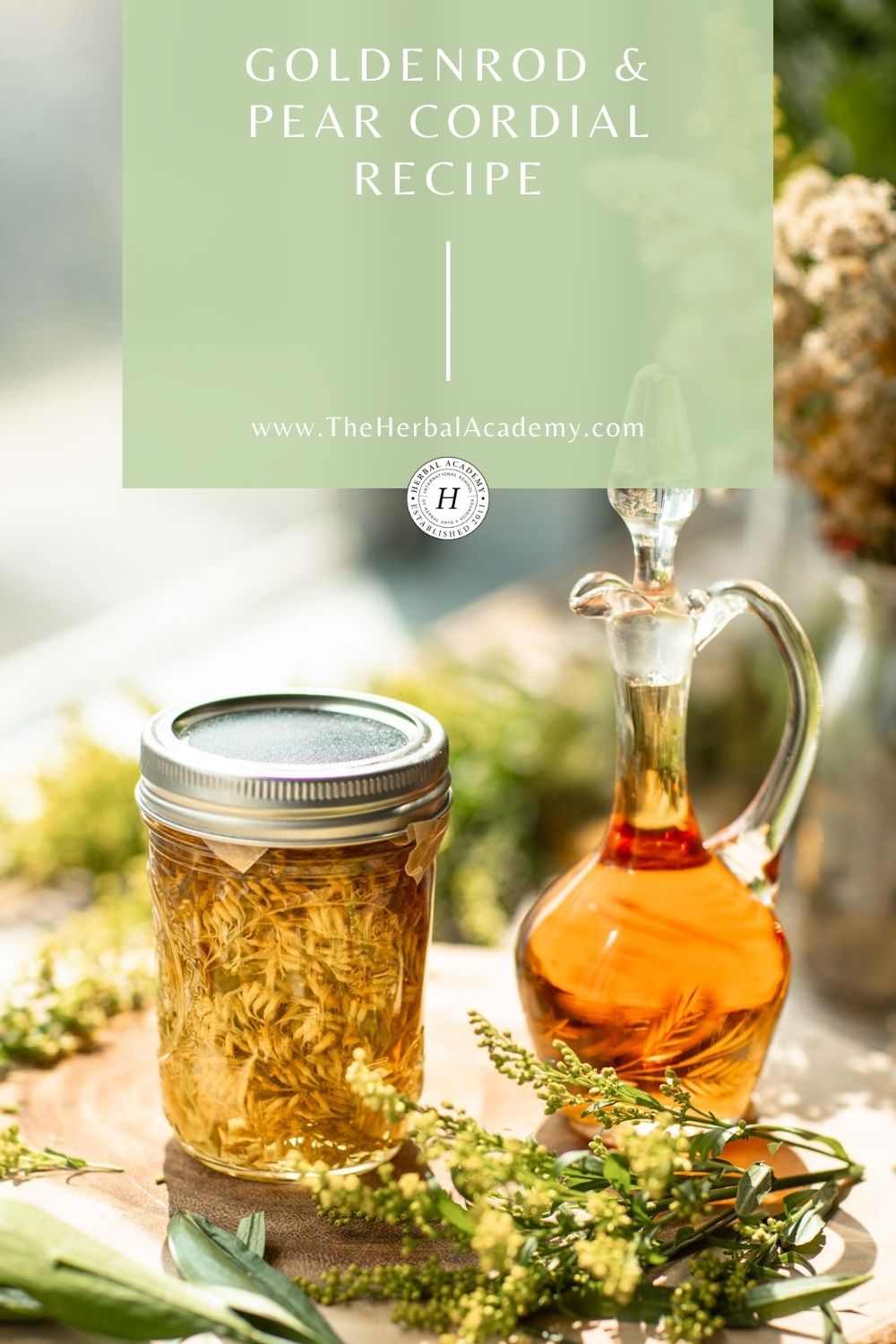
REFERENCES
Herbal Academy. (n.d). goldenrod monograph. The Herbarium. Retrieved from: https://herbarium.theherbalacademy.com/monographs/#/monograph/5103
Vorderbruggen, M. (2015). Foraging. Indianapolis, IN: DK Publishing.








